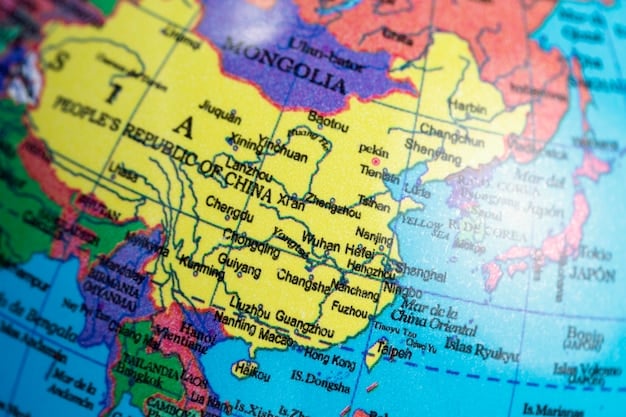Geopolitical Instability: Analyzing the Impact on US Economic Security

Analyzing the Impact of Geopolitical Instability on Global Trade and US Economic Security reveals profound implications for the US economy, affecting supply chains, trade relationships, and investment flows, thereby necessitating strategic policy responses to mitigate risks and safeguard economic stability.
Geopolitical instability has become an undeniable force shaping the global economic landscape. Understanding the intricate ways in which this instability impacts international trade and, specifically, US economic security is crucial for businesses, policymakers, and individuals alike.
Understanding Geopolitical Instability and its Global Reach
Geopolitical instability refers to the state of heightened tensions and uncertainties in the global political arena. This can stem from various factors, including conflicts between nations, political upheaval within countries, and shifts in global power dynamics.
The effects of geopolitical instability are far-reaching, impacting not only the countries directly involved but also the broader global community.
Defining Geopolitical Instability
Geopolitical instability goes beyond simple political disagreements. It encompasses situations where the risk of conflict, political violence, or sudden regime changes is significantly elevated.
Factors Contributing to Instability
Several factors can contribute to geopolitical instability, including:
- Rising nationalism and protectionist policies
- Territorial disputes and border conflicts
- Resource scarcity and competition
- The proliferation of advanced military technologies

Geopolitical instability is a complex web of interconnected factors that can quickly escalate and disrupt the global trade system. Understanding these factors is essential for assessing the potential risks to the US economic security.
The Impact on Global Trade Flows
Global trade, the lifeblood of the world economy, is particularly vulnerable to geopolitical instability. Conflicts and tensions can disrupt supply chains, increase trade barriers, and divert trade routes.
These disruptions can have significant consequences for businesses and consumers worldwide.
Supply Chain Disruptions
Geopolitical instability often leads to disruptions in supply chains. When conflict zones coincide with key production or transit hubs, the flow of goods and raw materials is severely impeded.
Increased Trade Barriers
Trade barriers, such as tariffs and sanctions, are often imposed in response to geopolitical events. These barriers can restrict trade between countries, leading to reduced economic activity and higher prices for consumers.
Case Studies of Trade Disruptions
Recent examples of geopolitical instability impacting trade include:
- The war in Ukraine, which has disrupted the supply of grains and energy, leading to increased food and energy prices worldwide.
- Trade tensions between the US and China, which have resulted in tariffs on billions of dollars worth of goods.
- Political instability in certain African nations impacting the extraction and export of key minerals.
Geopolitical instability causes significant disruptions to global trade flows. Businesses relying on international supply chains must remain vigilant, diversify their sourcing, and adjust their strategies to mitigate risk.
US Economic Security: Key Vulnerabilities
The US economy, while robust, is not immune to the effects of geopolitical instability. Several vulnerabilities can expose the US to economic shocks from abroad.
These vulnerabilities range from reliance on specific suppliers to exposure to certain geopolitical risks.
Dependence on Critical Resources
The US relies on imports for many critical resources, including rare earth minerals, essential for manufacturing electronics and renewable energy technologies. Geopolitical instability in countries that supply these resources can jeopardize US industries.
Exposure to Financial Shocks
Geopolitical events can trigger financial market volatility, leading to a decline in investment and consumer confidence in the US. A sudden crisis abroad can quickly spread to US financial markets.
Cybersecurity Threats
Geopolitical tensions have led to an increase in cyberattacks targeting US businesses and critical infrastructure. These attacks can disrupt operations, steal sensitive data, and inflict significant economic damage.

Recognizing these vulnerabilities is the first step toward developing strategies to strengthen US economic resilience and mitigate the risks associated with geopolitical instability.
Strategies for Mitigating Risks
To safeguard its economic security in an era of geopolitical volatility, the US needs to adopt a multi-faceted approach involving government, business, and individuals.
These strategies range from diversifying supply chains to investing in domestic production and resilience.
Diversifying Supply Chains
Reducing reliance on single suppliers is essential. Businesses should explore alternative sourcing options, even if they are slightly more expensive, to enhance supply chain resilience.
Investing in Domestic Production
Encouraging domestic manufacturing of critical goods can reduce reliance on foreign suppliers and create jobs in the US. Government incentives and subsidies can play a crucial role in promoting domestic production.
Strengthening Cybersecurity
Investing in cybersecurity infrastructure and training is essential for protecting businesses and critical infrastructure from cyberattacks. Collaboration between government and the private sector is crucial in enhancing cybersecurity resilience.
By implementing these risk mitigation strategies, the US can bolster its economic security and reduce vulnerability to the disruptions caused by geopolitical instability.
The Role of Government Policy
Government policy plays a vital role in shaping the US response to geopolitical instability. Strategic policies can help protect US economic interests and promote stability.
These policies range from trade agreements to sanctions and foreign aid.
Trade Agreements and Alliances
Trade agreements with reliable partners can diversify trade relationships and reduce dependence on countries prone to geopolitical instability. Strengthening alliances with like-minded nations can also enhance economic resilience.
Sanctions and Export Controls
Sanctions and export controls can be used to deter aggressive behavior and protect US national security interests; however, these tools must be carefully targeted to minimize unintended consequences on the US economy.
Foreign Aid and Development Assistance
Providing foreign aid and development assistance to developing countries can promote stability and reduce the likelihood of conflict. These investments can also create new markets for US goods and services.
Government policy is a critical tool in navigating the complex landscape of geopolitical instability and safeguarding US economic security.
The Future of Global Trade and US Economic Security
The future of global trade is likely to be characterized by increased volatility and uncertainty. The US must adapt to this new reality by strengthening its economic resilience and adopting a proactive approach to managing geopolitical risks.
The interconnectedness of the global economy means that events in one part of the world can quickly have repercussions elsewhere.
Emerging Technologies and Trade
Emerging technologies, such as artificial intelligence and blockchain, have the potential to transform global trade. These technologies can enhance efficiency, reduce costs, and improve transparency. However, they also pose new challenges, such as cybersecurity risks and the potential for job displacement.
The Rise of Regionalism
Regional trade agreements are becoming increasingly important in the global economy. The US needs to actively engage in regional trade initiatives to ensure that it remains competitive and has access to key markets.
Building Resilience for the Future
Preparing for future disruptions requires a commitment to innovation, diversification, and collaboration. By building resilience into its economic system, the US can weather the storms of geopolitical instability and emerge stronger in the long run.
| Key Aspect | Brief Description |
|---|---|
| 🌍 Global Reach | Instability affects all nations, impacting trade and economies globally. |
| ⛓️ Supply Chains | Disruptions in key regions can halt the flow of goods and resources. |
| 🛡️ US Security | Critical resource dependence and cyber threats expose vulnerabilities. |
| 🤝 Policy Roles | Strategic policies are vital for protecting and stabilizing US interests. |
Frequently Asked Questions
▼
Geopolitical instability arises from conflicts, political unrest, and power shifts, creating uncertainty globally. These events significantly disrupt international relations and economic activities.
▼
Trade barriers, like tariffs and sanctions, restrict international trade, leading to higher consumer prices and reduced economic growth. They complicate global supply chains and hinder market access.
▼
The U.S. relies on imported resources and faces cyber threats, making it susceptible to economic shocks from geopolitical tensions. Dependency increases risk during international crises.
▼
Diversifying supply chains, boosting domestic production, and strengthening cybersecurity help mitigate global trade risks. These strategies enhance resilience against geopolitical disruptions efficiently.
▼
Government policies like trade agreements, sanctions, and foreign aid are critical for safeguarding economic stability. These measures protect national interests and foster global economic balance.
Conclusion
In conclusion, analyzing the impact of geopolitical instability on global trade and US economic security reveals a complex web of challenges and opportunities. By understanding these dynamics and implementing strategic policies, the US can navigate these turbulent times and safeguard its economic future.





